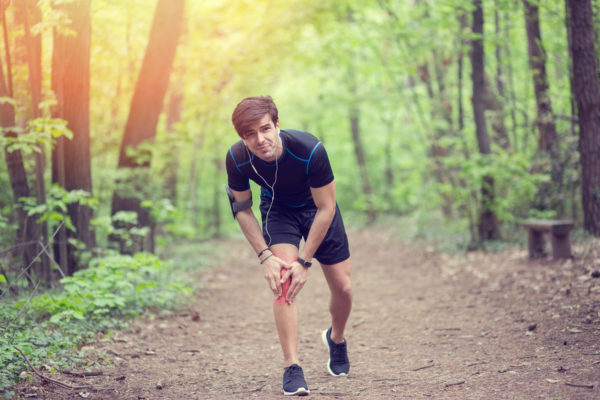
Knee injuries are possibly the most common injury that runners experience. In fact, it is one of the most likely reasons to keep you from running.
In this guide, we’ll explore the common knee injuries that runners encounter, shedding light on these pesky pains that can disrupt your stride. Whether you’re a seasoned marathoner or a beginner hitting the pavement for the first time, understanding these injuries is key to keeping your runs pain-free.
Overuse Injuries
1) Runner’s Knee (Patellofemoral Pain Syndrome)
What is it? Runner’s Knee, also known as Patellofemoral Pain Syndrome, is one of the most common issues for runners. It often occurs due to overuse, especially when runners increase their mileage too quickly.
Symptoms:
- A dull pain behind or around the kneecap
- Pain that worsens when you bend the knee
- Increased pain when walking downstairs or downhill
- Swelling around the kneecap
- Popping or grinding sensations in the knee
Why does it happen? The knee relies on a balance of thigh muscles to move up and down properly, and overrunning can accentuate any muscular imbalance and loading the soft tissues, causing soreness.
This imbalance is often caused by overpronating (running with your feet turned outward) or supinating (not pronating at all on ground contact). Also, if you hit the ground with your heels while running, the shock travels farther up your legs than if you hit at the middle of your step.
2) Iliotibial Band Syndrome (ITBS)
What is it? Iliotibial Band Syndrome (ITBS) is another common cause of knee pain for runners. The iliotibial band is a thick band of tissue running down the outside of your thigh, from your hip to your knee.
Symptoms:
- Pain on the outside of the knee
- Discomfort that usually begins after running for a certain distance
- Pain that may worsen with continued activity
Why does it happen? As you run, this band can rub against the outside of the knees, causing a pain just above the joint. This condition can also result from overtraining and from not stretching enough after exercise. Running on banked surfaces or in worn-out shoes can also contribute to ITBS.
3) Patellar Tendinitis (Jumper’s Knee)
What is it? Patellar tendinitis, also known as Jumper’s Knee, involves inflammation of the patellar tendon, which connects the kneecap to the shinbone.
Symptoms:
- Pain and tenderness at the base of the kneecap
- Pain that worsens with activity, especially jumping or rapid changes in direction
Why does it happen? This condition is common in activities involving frequent jumping or rapid changes in direction. The repetitive stress on the patellar tendon from these activities can cause inflammation and pain.
Acute Injuries
1) Meniscus Tears
What is it? The meniscus is a C-shaped piece of cartilage that acts as a cushion between your thigh bone and shinbone. Tears in the meniscus can occur from sudden twists or turns, especially when your foot is planted and your knee is bent.
Symptoms:
- Knee pain
- Swelling
- Difficulty moving the knee
- A catching or locking sensation
Why does it happen? Meniscus tears can result from acute injuries, such as a sudden twist or turn. They can also develop over time due to degeneration and wear and tear on the knee joint.
2) Ligament Injuries (ACL, PCL, MCL)
What are they? Ligament injuries include tears or sprains in the ACL (anterior cruciate ligament), PCL (posterior cruciate ligament), or MCL (medial collateral ligament). These ligaments help stabilize the knee joint.
Symptoms:
- Pain and swelling
- Instability in the knee
- A popping sensation at the time of injury
Why do they happen? Ligament injuries often result from sudden stops, changes in direction, or awkward landings. These injuries are common in sports that involve cutting and pivoting movements.
Inflammatory Conditions
1) Knee Bursitis
What is it? Knee bursitis is inflammation of the bursae, small fluid-filled sacs that cushion the knee joint.
Symptoms:
- Swelling
- Tenderness
- Pain when moving the knee
Why does it happen? Bursitis can be caused by repetitive kneeling, overuse, or direct impact to the knee. The repeated pressure on the bursae can lead to inflammation and pain.
2) Osteoarthritis
What is it? Osteoarthritis involves the degeneration of joint cartilage and the underlying bone, often due to aging or overuse.
Symptoms:
- Pain and stiffness in the knee
- Reduced range of motion
- Swelling
Why does it happen? Osteoarthritis can result from overuse, aging, previous knee injuries, or genetic predisposition. The wear and tear on the knee joint over time can lead to the breakdown of cartilage and the development of osteoarthritis.
Knee Injuries? No More!
Initial Self-Care
For mild knee pain, initial self-care can be effective. Follow the RICE method:
- Rest: Avoid activities that cause pain.
- Ice: Apply ice packs to reduce swelling.
- Compression: Use compression bandages to manage swelling.
- Elevation: Elevate your knee to decrease swelling.
Over-the-counter pain relief options like ibuprofen or acetaminophen can also help manage pain.
To rectify muscular imbalance, you might shorten your running distance and make sure your feet hit the ground properly. Running stores stock shoes specially geared for overpronators or supinators.
Sometimes, runners will need custom orthotics to help control foot function.
The proper shoes, especially those with shock-absorbing soles, can reduce the impact on your knees. In addition to proper footwear, always start with a slow warm-up and finish with stretching to loosen up the leg muscles.
When to Seek Medical Attention
It’s crucial to seek medical attention if you experience:
- Severe pain or swelling
- Inability to bear weight on the knee
- Noticeable knee deformity
- Persistent pain that doesn’t improve with rest
Early diagnosis and treatment are essential to prevent further damage and ensure a quicker recovery.
Physical Therapy
For further relief, an individualized series of exercises might be in order. A physical therapist can design a personalized exercise program to strengthen the knee and improve flexibility, so you can keep running and improve your workout regimen.
Did you know you have Direct Access* to Physical Therapy? No referral, no problem!
Want daily content The Jackson Clinics? Make sure to give us a Follow on Instagram!


















